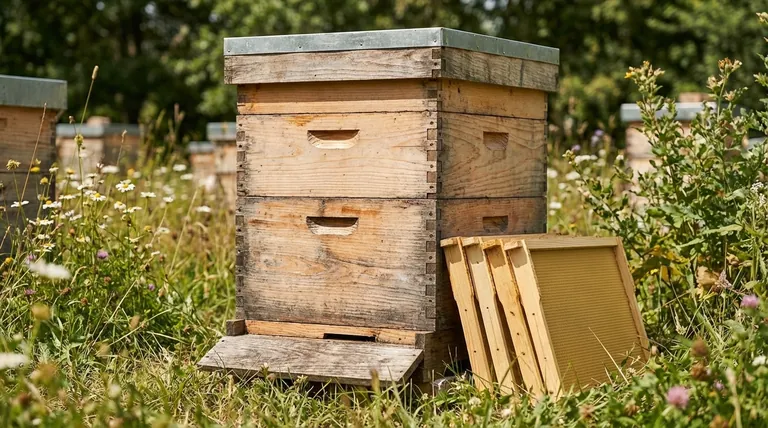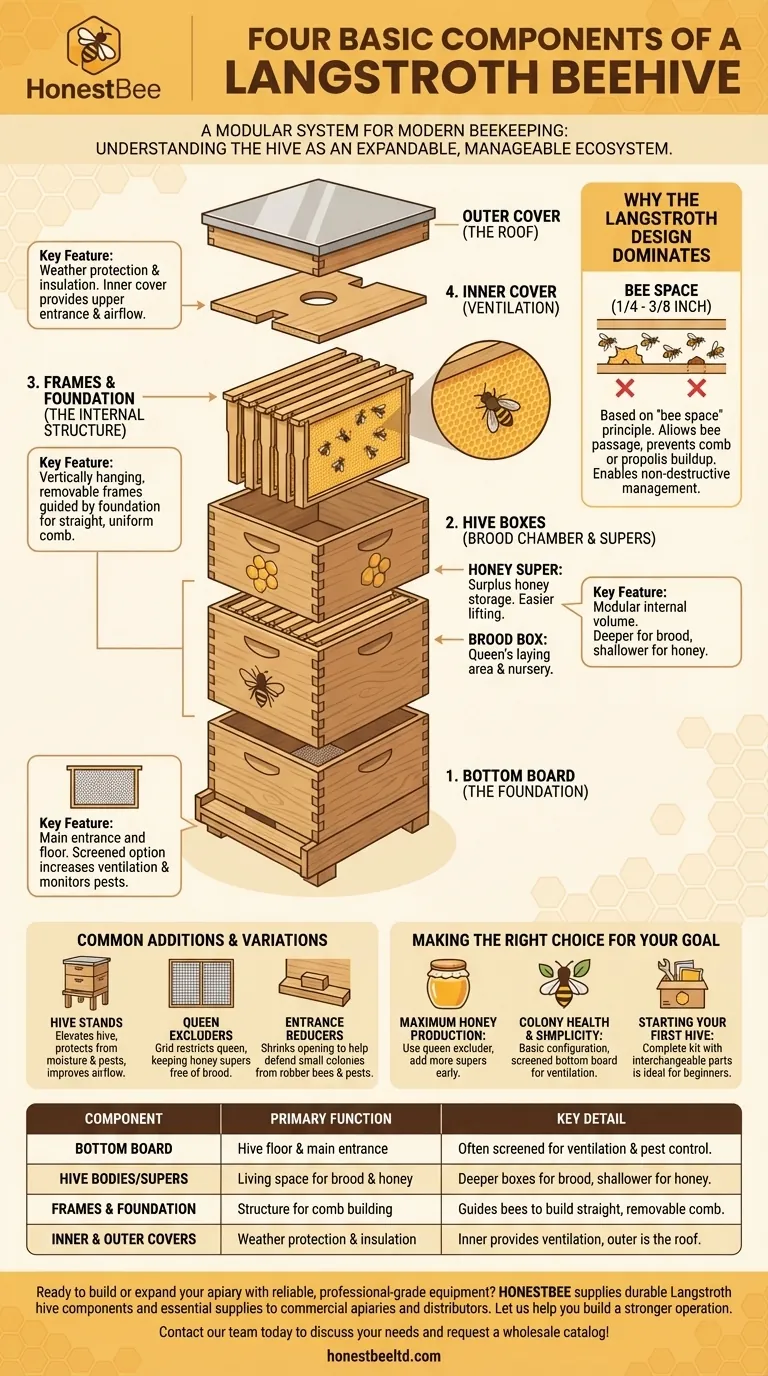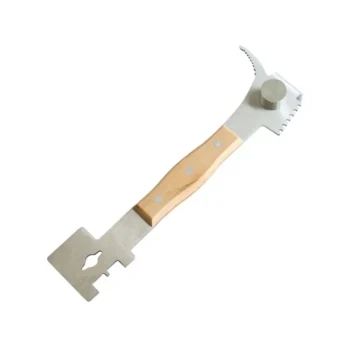At its core, a modern Langstroth beehive is a modular system built from four fundamental components. These are the bottom board, one or more hive boxes (often called supers), a set of removable frames for each box, and a pair of covers to protect the hive from the elements.
Understanding these components isn't just about identifying parts; it's about seeing the hive as an expandable, manageable ecosystem designed to meet the needs of both the bee colony and the beekeeper.

Why the Langstroth Design Dominates
The Langstroth hive became the industry standard for a simple reason: its design is based on the principle of "bee space." This specific gap (roughly 1/4 to 3/8 of an inch) is just enough to allow bees to pass through, but too small for them to build comb in and too large to fill with propolis (a resinous sealant).
This innovation allows for the hive's key feature: vertically hanging, removable frames. Before this, beekeepers often had to destroy the colony's comb to inspect the hive or harvest honey. The Langstroth system allows for non-destructive management, making modern beekeeping possible.
Deconstructing the Hive: A Component-by-Component Guide
A Langstroth hive is best understood as a vertical stack, with each component serving a specific function for the colony living inside.
The Foundation: The Bottom Board
The bottom board serves as the floor of the hive. It provides a base for stacking the boxes and creates the main entrance and exit for the bees.
Most starter kits come with a solid bottom board. Many beekeepers opt for a screened bottom board to increase ventilation and help with monitoring and controlling varroa mites, a common honey bee parasite.
The Living Quarters: Hive Bodies and Supers
These are simply the boxes that are stacked to create the hive's interior volume. While they are all technically "supers" (from "superstructure"), they are often differentiated by their role.
The brood box (or hive body) is the deepest box and sits at the bottom of the stack. This is the heart of the colony, where the queen lays her eggs and the bees raise the next generation of brood.
Honey supers are the shallower boxes stacked on top of the brood box. These are intended for the bees to store surplus honey. Their smaller size makes them lighter and easier for the beekeeper to lift when full of honey.
The Internal Structure: Frames and Foundation
Frames are the most critical component of the Langstroth system. These wooden or plastic rectangles hang vertically inside each hive box, providing the structure upon which bees build their honeycomb.
Most frames are fitted with foundation, which is a thin sheet of plastic or beeswax imprinted with a hexagonal cell pattern. This foundation guides the bees, encouraging them to build straight, uniform comb that is easy to remove and inspect.
The Roof: Inner and Outer Covers
The hive is sealed with a two-part cover system that provides insulation and weather protection.
The inner cover is a flat board that sits directly on top of the uppermost box. It typically has a notch or hole to provide an upper entrance and ventilation, while preventing the bees from sealing the outer cover to the hive.
The outer cover, often called a telescoping cover, fits over the top of the hive and the edges of the top box. It is the hive's primary defense against rain, snow, and sun, acting as its final roof.
Understanding Common Additions and Variations
While the four components above form a basic hive, most beekeepers use a few additional pieces to manage their colonies more effectively.
Hive Stands
A hive stand is a simple but crucial addition. Elevating the hive off the ground protects the bottom board from ground moisture and rot, improves air circulation, and makes it more difficult for pests like ants to enter.
Queen Excluders
A queen excluder is a flat metal or plastic grid with openings that are large enough for worker bees to pass through, but too small for the larger queen. It is placed between the brood box and the honey supers to ensure the queen only lays eggs in the designated brood area, keeping the honey supers free of brood.
Entrance Reducers
An entrance reducer is a small piece of wood with different-sized notches cut into it. It is placed in the main entrance on the bottom board to shrink the opening, which helps a small or new colony defend itself from robber bees or pests.
Making the Right Choice for Your Goal
The modularity of the Langstroth hive allows you to configure it based on your specific objectives.
- If your primary focus is maximum honey production: Use a queen excluder to keep your honey supers clean and be ready to add more supers as the nectar flow begins.
- If your primary focus is colony health and simplicity: Start with a basic configuration and consider a screened bottom board for better ventilation and pest monitoring.
- If your primary focus is starting your first hive: Purchase a complete kit that includes all the basic components, as the interchangeable nature of Langstroth parts is a major advantage for beginners.
Understanding how these parts function together is the first step toward becoming a successful and responsible beekeeper.
Summary Table:
| Component | Primary Function | Key Detail |
|---|---|---|
| Bottom Board | Hive floor and main entrance | Often screened for ventilation & pest control |
| Hive Bodies/Supers | Living space for brood and honey storage | Deeper boxes for brood, shallower for honey |
| Frames & Foundation | Structure for bees to build comb | Guides bees to build straight, removable comb |
| Inner & Outer Covers | Weather protection and insulation | Inner cover provides ventilation, outer is the roof |
Ready to build or expand your apiary with reliable, professional-grade equipment? HONESTBEE supplies durable Langstroth hive components and essential beekeeping supplies to commercial apiaries and beekeeping equipment distributors through our wholesale-focused operations. Let us help you build a stronger, more productive operation. Contact our team today to discuss your needs and request a wholesale catalog!
Visual Guide

Related Products
- Long Langstroth Style Horizontal Top Bar Hive for Wholesale
- HONESTBEE Professional Long Handled Hive Tool with Precision Cutting Blade
- Multi-Function Hive Tool with Integrated Hammer for Beekeeping
- Ergonomic Two Person Foldable Hive Lifter
- Professional Galvanized Hive Strap with Secure Locking Buckle for Beekeeping
People Also Ask
- What are the most popular types of hives besides the Langstroth? Top Bar & Horizontal Hives Explained
- What are the benefits of the top bar hive? A Guide to Ergonomic, Natural Beekeeping
- What are the advantages of a top bar hive? Simpler, Bee-Centric Beekeeping for All
- What are the box management requirements for a top bar hive vs. Langstroth? Choose Your Hive Strategy
- What are the benefits of a top bar hive? A Natural, Low-Impact Approach to Beekeeping



















